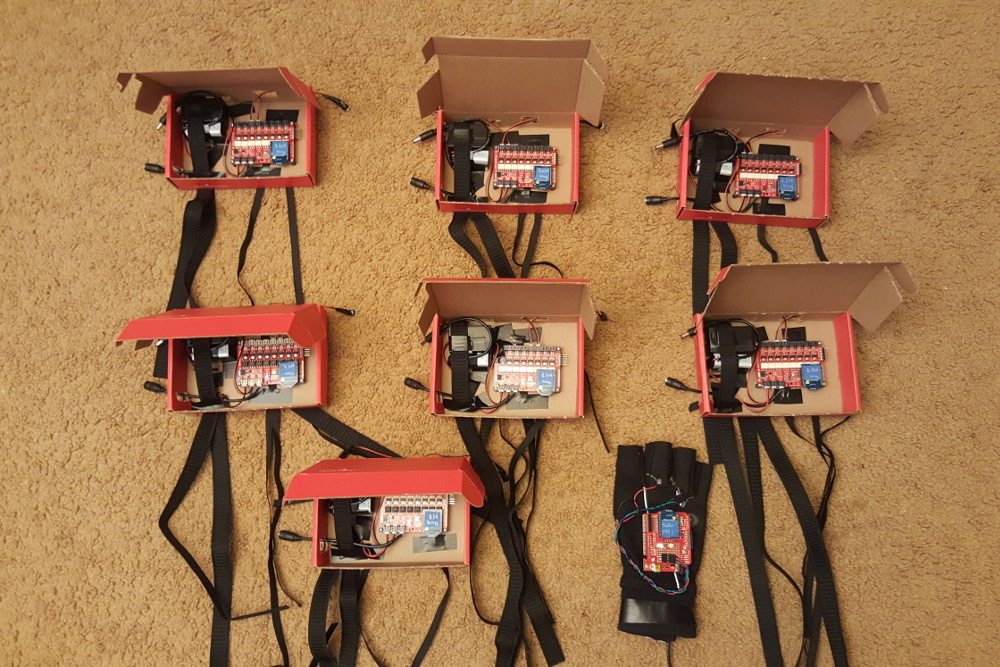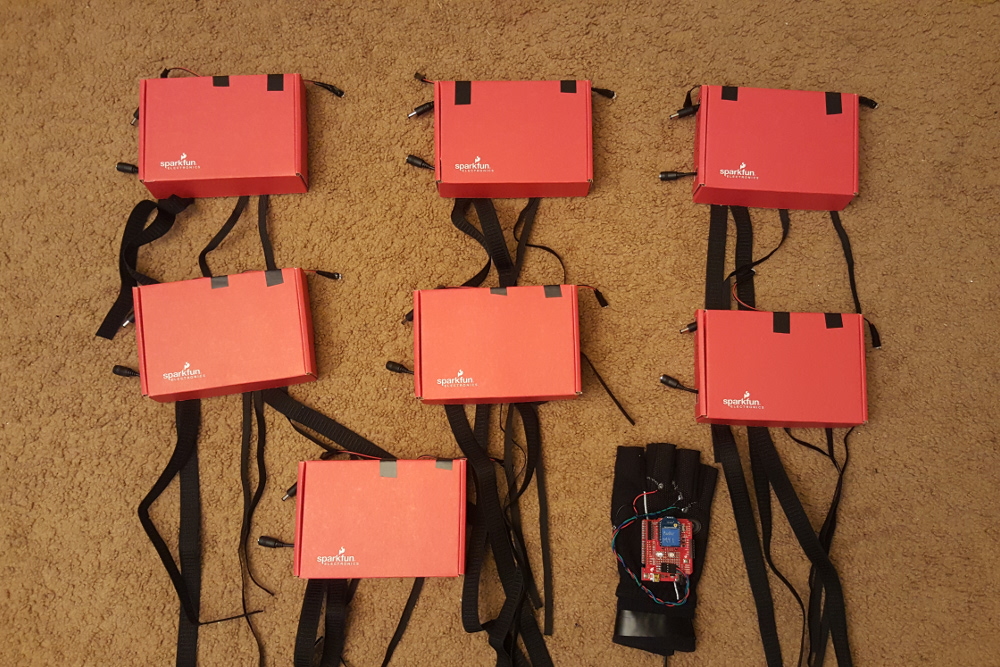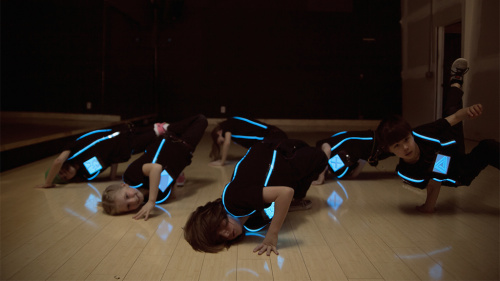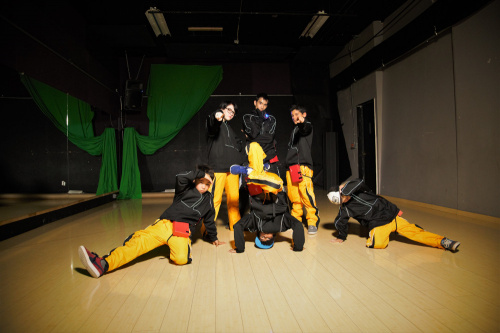Note: If you have not read my previous blog posts, make sure to check it out before reading further!
As with any project, you will want to start small and work on the project in parts. In this case, my initial goal was to built one suit for Mark IV before making six more for each student. This has been an ambitious goal of mine since making the first version for my students back in 2014.
Once I created the EL suits for each student, I decided to move forward to the next goal and control two channels wirelessly. Satisfied with a wireless blink test on a breadboard between a controller and one sequencer, I tested the setup remotely with a wireless glove and three sequencers. After a few successful tests, off I went to modify the EL Sequencers, hacking the EL inverters, making custom EL wire extension cables, cutting out enclosures, and connecting the hardware for each dancer. This was tedious but not as time consuming as sewing the EL wire along each suit's arms and legs. I had enough time so I decided to go the extra mile to sequence the suits to the beat of the music three times in the piece.
 |
 |
How did the performance go? Overall, it went well. However, I found it difficult to dance and control the suits simultaneously. One of the sections that I decided to sync the animation with had a lot going on. The music was fast music and there was lot of movement. This was not ideal as the controller had to be in the correct mode before I was able to hit the send button. What I could have done differently with this setup would have been to not to have as much movement when hitting the send button.
Mark IV: EL Wire Dance Suit in 2017
How Do You Build Such a Thing? Part 3
Check out the tutorial below for details on how to complete this project.
Wireless Controlled Wearable EL Wire Dance Suit
October 31, 2019
In this tutorial, we will build an EL wire dance suit that can be controlled by a wireless glove controller!
Have you built an EL Wire Suit before? If you have, did you use an XBee or a different wireless module? Let us know your thoughts below in the comments. Otherwise, tune in some time in the future for Mark V for some additional upgrades and improvements! ;D








I made a Halloween suit for my son years ago, but used the EL-Tape strips. https://www.sparkfun.com/products/10796 and the El Sequencer controller.
Turns out the tape is not as flexible as the wire is and we had a few segments break and go dark.
Sweet. While the EL tape is brighter, I found that the solder joints between the EL Tape and the two wires were fragile. I had a few wires break when I used them for the first iteration during a show. It was also not as flexible just as you had experienced. It was a simple rework but I did not have the time during the show to carefully the solder wires back. I would have probably added some hot glue to reinforce the joint or some backing to support the EL tape. I designed the EL shirts in a way to easily slide the EL tape between the shirt and vinyl.
If you remember, did the EL tape break where the joint was or in the middle of the tape?
They broke at the joint
I did a TRON dance piece using EL wire and sparkfun's 8 channel EL sequencer. I made an RF remote control so a 3rd party could control run the sequence. It worked well except: 1. When the audience showed up the 2.4ghz noise floor went through the roof and my remote didn't work so well. Next time I will auto sequence them so they just run the program. A little more work to get the sequences right but it eliminates a lot of runtime complexity
I was wondering if there would be any wireless interference when using a different wireless module. This was one of my concerns before the performance. As a backup plan, I had the EL Wire stay on when the EL Sequencers were not being triggered. The short animations synced with the music was just an extra added effect. If I had more time or assistance, I would have tried experimenting with different software (like what Bill Ported did with Vixen Lights and used a Python script) to translate the music to the animation. Then again, that requires triggering the EL Sequencer right when the music starts.
Yeah, I carefully planned out where the two 3M EL wires were attached on the hoodie and pants and how my students moved. EL wire is flexible, to a point. This was yet another concern of mine as I started this project so I limited myself to two 3M EL wires per dancer. Sharp bends can break the corona wires wrapping around the EL wire's core so I tried to have my students avoid putting a lot of weight where the EL wire was attached. Out of all the rehearsals and performances where I have used the EL wire, I had one break due to the enclosure's corner pushing against it. I had to surgically repair the EL wire that was attached to fabric. Luckily, this broke before one of the shows and I had some experience with rework.
A few random thoughts:
A few years ago, I built a "Flashy Santa Hat" based on some Neo-Pixel LEDs (11 of them, to be exact) with a (5 volt) Pro-Mini to control them. It has a 3-D accellerometer that is used to detect movement, and randomly change the patterns on the LEDs. I also included an analog light sensor so it could adjust the Neo-Pixels as they can be blindingly bright. (Also check out these sewable LED mounts which is what I used for the Neo-Pixels.). Maybe have the lighting synchronize to the wearer's motions?
You also mention rechargable batteries. I'd be a bit nervous about having LiPos in suits -- need to arrange so that if one does catch fire it can be removed QUICKLY. I'd be more inclined to use 3xAA (or 3xAAA) alkalines -- they will provide near enough to 5V that most things won't care, and can provide several hours of operation per set. (Durcells are also pretty reasonably priced at Costco!). If you need 6V, 4xAA and 4xAAA are readily available. If you need more capacity and really need 9V, I strongly suspect that Digi-Key will have something you can use for 6xAA or 6xAAA. (The aforementioned Flashy Santa Hat used a 3xAAA and it works well.)
On synchronizing to music, I know that there are "commercially available" solutions that folks use to synchronize Christmas displays to music, but I suspect that they'd be out of your budget range.
I remember that project that you shared. =) I had experimented with a 3-axis accelerometer before using non-addressable LEDs in version III but it would be interesting to test it out with the EL Sequencer. I finally experimented with addressable LEDs and a sound detector in version VI. It turned out pretty good. For simplicity, I just adjusted the brightness in code to light up at a certain value.
Yeah, I am pretty paranoid about using LiPo batteries on the suits with my students. I would want the LiPo batteries in enclosures to protect the it from being punctured since they are moving a lot. I would also want to ensure that the circuit is not pulling a lot of power and can be easily disconnected. AA Alkalines seemed a bit bulky to achieve the desired voltage which was why I decided to use 9V Alkaline batteries. NiMH is another option that has been on my mind but I have not experimented with that battery chemistry as much.
I have heard of Vixen Lights that can be downloaded for free the last time I checked. If I had some bandwidth before the performance in 2017, I would have wanted to experiment with the software to translate the music to the animation and possibly broadcast it to the other Sequencers. In my research, I did find that there were a few (like Bill Porter) that have used the software with a Python Script to control LEDs in Arduino.